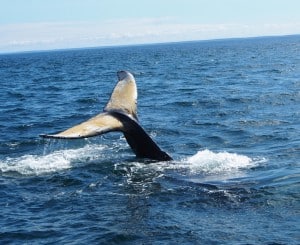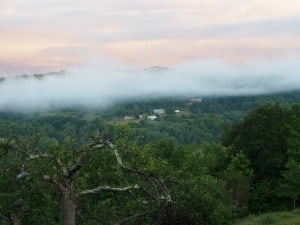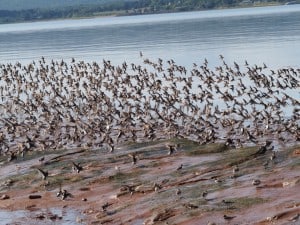I didn’t know whether to simply stare in awe or risk missing part of the show by attempting to get the perfect picture. Swimming alongside our whale-watching boat were two enormous Humpback Whales, a 40-50 foot female and her only slightly smaller calf. The two cetaceans moved gently up and down with the waves, sometimes turning on their sides or back and swimming with their huge flippers high in the air. From time to time, they would dive deep below the surface, raising their huge black and white tails out of the water for all to see. I had to remind myself that I was indeed looking at mammals, and that their distant ancestors were actually land dwellers.
However, whales were only part of the show on this Brier Island adventure. Seabirds, too, were a constant presence as eiders, puffins, gannets, storm-petrels, shearwaters, phalaropes and gulls either flew past the boat or rested on the water. The gannets were particularly impressive as they fed by plummeting head-first into the water like avian Kamikazes. White-sided Dolphins were also visible much of the time. In fact, we witnessed the rare sight of at least 100 of these creatures churning up the water in the harbour when we returned to dock.
Whale and seabird-watching was just one of many nature adventures that my wife and I enjoyed earlier this month during a trip to the Annapolis Valley and Fundy Shore of Nova Scotia. We had the privilege of staying in a charming old house in picturesque Bear River, which is located just southeast of Digby. The house belongs to Mitch Brownstein, a Peterborough resident. For anyone wanting to discover nature in Atlantic Canada – not to mention the huge number of culinary and cultural experiences available – it’s hard to imagine a more interesting region.
Bear River
Bear River, also known as “the tidal village on stilts” is situated at the head of the tidewaters of the river of the same name. One of the first things you notice upon arriving is the abundance of Red Oaks, many of which are huge. The village was once an important shipbuilding centre but is now home to a thriving artistic community as well as several vineyards, one of which is located right next door to where we stayed. Artist studios and galleries can be found in both the village and immediate area. Mitch’s four-bedroom Ontario Gothic-style house was built in 1840 and is located just outside of the village. It overlooks the heavily wooded banks of the Bear River. A small, one-bedroom cottage is located adjacent to the house. On one side of the 20-acre property, a beautiful shaded brook with steep waterfalls tumbles down over slate bedrock and through stands of giant Eastern Hemlocks and White Pines before eventually coming out at the river. You can easily paddle down river to the Annapolis Basin and even fish for mackerel.
In the evening, we often built a fire and sat outside watching the ever-changing sky and how the fog would drift up the valley from the Bay of Fundy. On several occasions, we could even hear the snorting of White-tailed Deer as they fed in the nearby meadow. Once darkness fell, the huge swath of dark sky offered up a majestic view of the summer constellations.
Bear River is not far from Saint Mary’s Bay, which is home to a large French Acadian population. We spent an entire day exploring this area and learning about the still-thriving Acadian communities. In addition to the many artisans, the area is famous for its Kitchen Parties, the Clare Bluegrass Festival and the Acadian museum at Church Point. In terms of natural history, Smuggler’s Cove Provincial Park and Mavillette Beach are interesting destinations. The latter is home to birds such as Willets and Sharp-tailed Sparrows. There is also a program called “Living Wharves” which tells the story behind the local fishing industry. You can actually meet with fishermen (and women) at community wharves throughout the region to hear their stories and learn about their way of life.
Shorebirds
For years I had wanted to see the huge flocks of mostly Semipalmated Sandpipers that visit the upper Bay of Fundy en route southward from nesting grounds in the sub-Arctic. Over a million of these sparrow-sized birds – roughly 75% of the world’s population – move through the Fundy area each summer, before embarking on a non-stop 72 hour flight over the ocean to their wintering grounds in South America. To take in the spectacle, we drove up the Valley to Evangeline Beach near Wolfville. The birds are attracted to the huge mud flats and food resources found there – most notably the millions of mudshrimp, which crawl about on the mud surface in search of mates.
The famous high tides of the Bay of Fundy – 52 feet in Wolfville! – force the birds off the mud flats and to the shoreline. They mill about in tight, nervous flocks as people walk the beach, swim and paddle-board. These and other disturbances – such as a Peregrine we observed – cause the birds to take flight in close formation above the water. Spectacular to see, the flocks veer in all directions as if controlled by a single brain. However, these flights come at a cost to the birds, since they burn up hard-earned fuel reserves needed for the next leg of the journey.
We also did some shorebird-watching at Pond Cove on Brier Island. Small flocks of Least Sandpipers, Black-bellied Plovers and Lesser Yellowlegs fed along the shore at low tide, while we enjoyed a picnic lunch after our whale-watching excursion. Brier Island is probably the premier birding destination in all of Nova Scotia. It is also fascinating for its vegetation, which includes a wide variety of rare orchids. We easily found at least a dozen Small Purple Fringed Orchids.
Annapolis Royal
Another highlight of the trip was visiting the historic town of Annapolis Royal. In addition to the beautifully preserved old homes and huge mature trees – including majestic American Elms – a major attraction is the Annapolis Royal Historic Gardens. We spent an entire morning wandering about the 17 acres of formal and informal gardens, which includes a rose collection of more than 270 cultivars. There is also a reconstructed Acadian house representing the pre-deportation 1671 time period. The Saturday morning Farmers’ and Traders’ Market was also well worth taking in. Local farmers and artisans offer a wonderful array of quality products.
Nature-viewing opportunities are close-by, as well. The highlight for us was the wilderness trail at Delaps Cove. It winds through boreal forest where ferns of at least eight species abound. Most impressive were the large stands of Cinnamon and Interrupted ferns. The trail then follows a stunning section of coastline, festooned with Wild Rose, Rhodora (Rhododendron canadense), and Seaside Goldenrod. At low tide, you can find blue mussels, kelp and dulse, which locals dry for a great salty snack! For anyone wanting to do an in-depth exploration of seashore ecosystems on the Bay of Fundy, Gael Tours in Smith’s Cove (just outside of Digby) runs an outing called “Plankton, Periwinkles and Predators”. The excursion includes collecting and observing plankton, exploring tidepools, sampling succulent seaweeds and even watching barnacles engage in a feeding frenzy.
The 1.2 kilometre French Basin Trail is also definitely worth doing if you visit Annapolis Royal. It is located right in the town and winds around a 38-acre marsh. We observed at least 100 American Black Ducks and Northern Shovelers, as well as a family of Sora rails.
If you are interested in exploring the Annapolis Valley and want to stay in Bear River, you can email Mitch Brownstein at mitchel_bro@yahoo.ca


